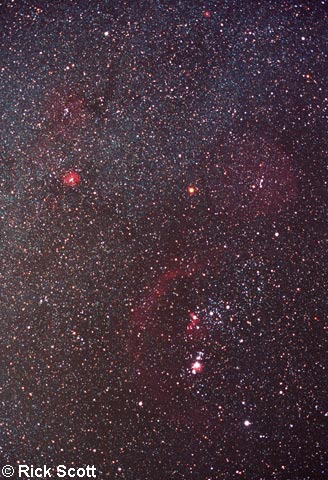

This photo is the longest exposure I've taken of this part of the night sky. In June of 1999, I got a new high-tech equatorial mount for my telescope so I could take long guided exposures. In December of 1999, I finally decided to try it out after learning how to use it well. Orion is in the lower right quarter and part of our Milky Way galaxy is cutting diagonally across the left half of the photo. The bright orange star in the middle is Betelgeuse and to its left in red is the Rosette nebula. The reddish "C" in the lower half is Bernard's Loop, a portion of a supernova remnant and at the top of the photograph is NGC 2174 another red emission nebula.
I took this photograph with my Olympus OM-3 camera and Zuiko (Olympus) 40mm f/2 lens mounted piggy-back on my Celestron 8 (circa 1973) telescope. The telescope with a 12mm reticle eyepiece was used to guide the exposure. I took this photo in the Sonoran desert about half way between Casa Grande and Gila Bend in Arizona on 4 December 1999. The exposure was one hour at f/2 and the film was Fuji 800 Super G 35mm negative film processed for ISO 400. I scanned the image with a Nikon Coolscan LS-2000 and used Adobe Photoshop for further processing.
Updated: 8 February 2000